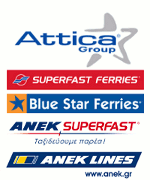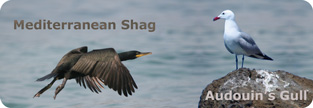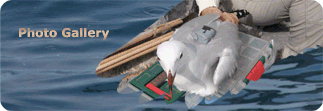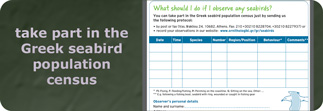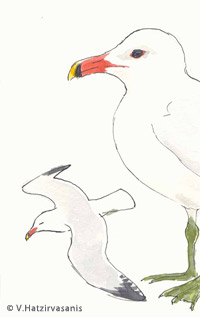
Audouin’s Gull is a gull species endemic of the Mediterranean, easily identified by its scarlet red bill and greyish-black legs. Until the 70’s, its global population was estimated only at 1.000 pairs. However, thanks to the increase of fishing, and therefore, of the amount of fish discards in western Mediterranean, global population has increased sharply. According to the latest estimations (BirdLife 2008), global population is 21.500 pairs, with 90% of it located in western Mediterranean, in Spain (the largest colony is located at the Evros Delta.
The species is classified as “Nearly Threatened” by BirdLife International. It is included in Annex I of the Birds Directive 2009/147/EC, in Annex II of the Bern Convention, and in Annex I of the Bonn Convention. In addition, it is classified as “Vulnerable” in the new Red Data Book of Endangered Animals of Greece (Handrinos & Kastritis, 2009).
Audouin’s gulls are present in Greece only during the breeding season, so our knowledge of the species is mainly reduced to this period of time. The Greek population is estimated around 350-500 pairs and breeds only in the Aegean, in colonies of 5 to 85 pairs. The colonies are located on isolated rocky islets with little vegetation, mainly in the Dodecanese, Fournoi, Amorgos, Paros, Sporades island complex, Lesvos, Lemnos, Chios and Crete. |
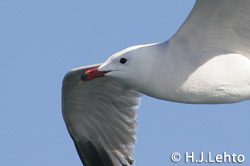 |
 |
In Greece, the species typically changes colony site from year to year, that is to say, the birds don’t return every year to the same site, but rather move to other nearby islets.
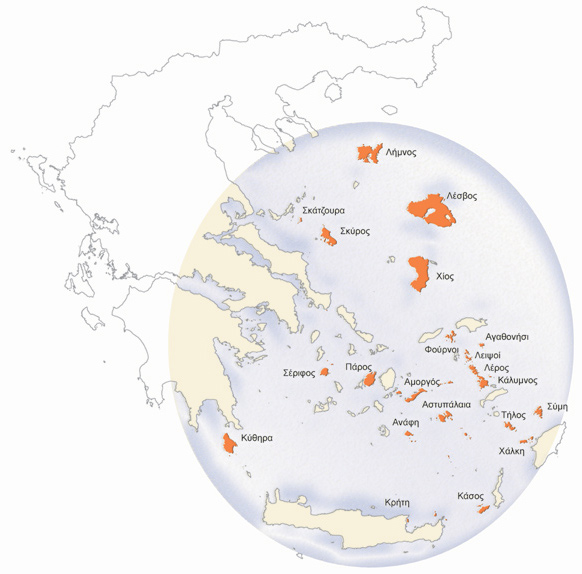
By the end of April, adults are already settled in the colonies, laying two to three eggs in grass-made nests located on the ground. Incubation lasts for three weeks and chicks start to hatch by mid May. A month later, fledglings are ready to fly, but will need four more years before they reach adulthood, when they will moult into the white adult plumage and start to breed. From mid July and onwards, both adults and juveniles start abandoning the colony and dispersing in the surrounding areas. From then on, wintering areas and migration routes of Greek populations remain unknown, although there have been resightings of ringed individuals in Cyprus, Crete, Malta, Lebanon, Tunisia and Spain!
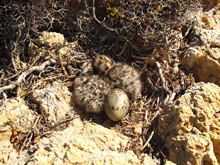 Audouin’s Gull feeds close the coast, mainly on small fish close to the sea surface which they skilfully catch by flying slowly just above the water. In western Mediterranean, the species feeds mainly on discards from fishing boats.
Audouin’s Gull feeds close the coast, mainly on small fish close to the sea surface which they skilfully catch by flying slowly just above the water. In western Mediterranean, the species feeds mainly on discards from fishing boats.
Audouin’s Gull in numbers
Length: 0,5 m
Wing span: 1,3 m
Distribution: Nests exclusively on Mediterranean islands
Greek population: 350 - 500 pairs
|
Threats
The species most significant threat is human disturbance during breeding season, which has direct impact on colony size and leads to small and isolated colonies. Human disturbance with negative impact on the colonies varies from stock breeding, over-grazing, fishing, hunting to tourism and construction of infrastructures. Other threats of course, are the decrease of fish stock, mortality by accidental trapping in fishing gear (by-catch), sea pollution, as well as egg and chick predation from rats, Yellow-legged gulls, or Hooded crows. Competition with Yellow-legged gulls for nesting sites and food also has a negative impact on the species.
How does the LIFE project help the species?
Different actions are being implemented within the framework of the LIFE project, aiming to increase our knowledge of the species ecology at sea and its threats, and to designate Marine IBAs. At the same time, in order to increase the species conservation status, different management actions will be tested, in particular those related to terrestrial and Yellow-legged Gull predation, and by-catch.
The following actions are being implemented in order to obtain the necessary information to fulfil the project’s objectives:
a) Population census in project regions, in order to locate breeding colonies and update the breeding population estimates.
b) Monitoring of selected breeding colonies in order to estimate breeding success.
c) Monitoring of adult individuals through GPS telemetry (implemented for the first time in Greece) in order to identify the species main foraging areas
d) Chick ringing in order to obtain information on the species migration routes
e) Preliminary estimation of the negative impact of Yellow-legged Gull predation and competition.
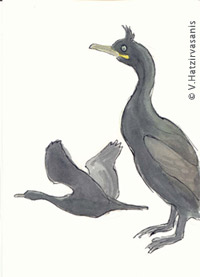 Greece hosts all three members of the Cormorant family: the Mediterranean Shag (Phalacrocorax aristotelis), the Great Cormorant (Phalacrocorax carbo) and the Pygmy Cormorant (Phalacrocorax pygmeus). It is noteworthy that the Mediterranean shags present in Greece are in fact a subspecies endemic of the Mediterranean (Phalacrocorax aristotelis desmarestii). The subspecies population is estimated to be fewer than 10.000 pairs, with 1.000-2.000 in the Greek islands of the Aegean and Ionian Sea. Although the knowledge about the species distribution and ecology in Greece has greatly improved during the last decade, there are still gaps, especially regarding the species distribution and behaviour at sea.
Greece hosts all three members of the Cormorant family: the Mediterranean Shag (Phalacrocorax aristotelis), the Great Cormorant (Phalacrocorax carbo) and the Pygmy Cormorant (Phalacrocorax pygmeus). It is noteworthy that the Mediterranean shags present in Greece are in fact a subspecies endemic of the Mediterranean (Phalacrocorax aristotelis desmarestii). The subspecies population is estimated to be fewer than 10.000 pairs, with 1.000-2.000 in the Greek islands of the Aegean and Ionian Sea. Although the knowledge about the species distribution and ecology in Greece has greatly improved during the last decade, there are still gaps, especially regarding the species distribution and behaviour at sea.
For the last six years, the Hellenic Ornithological Society (HOS) consistently surveys all of the species breeding and wintering sites in Greece; so far, 424 breeding sites have been recorded. In addition, HOS also carries out systematic monitoring and ringing of chicks and adult individuals at selected breeding colonies in North Sporades and North Aegean giving the first data on the species ecology and movements in Greece. Thus, in the last three years HOS fieldwork teams have covered around 3.200 km2 of sea areas while searching for the species feeding areas.
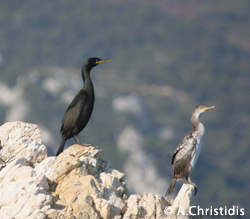 The Mediterranean Shag is protected both national and internationally: it is included in Annex I of the Birds Directive 2009/147/EC as well as in Annex II of the Bonn Convention; in addition, there is also an International Action Plan for the Mediterranean subspecies. The species is also classified as “Nearly Threatened” in the Red Data Book of Endangered Animals of Greece.
The Mediterranean Shag is protected both national and internationally: it is included in Annex I of the Birds Directive 2009/147/EC as well as in Annex II of the Bonn Convention; in addition, there is also an International Action Plan for the Mediterranean subspecies. The species is also classified as “Nearly Threatened” in the Red Data Book of Endangered Animals of Greece.
The Mediterranean Shag is a species typical of coastal areas, and unlike its close relatives the Great Cormorants and the Pygmy Cormorants, it can be found exclusively at sea. It is very frequently observed roosting or drying its plumage on rocks along the coastline, or fishing in the sea close to the coast. It feeds mainly on fish, diving up to 60 m to catch them. Its breeding range covers all of the Greek seas, from Gavdos in the Libyan Sea, to Thasos in the North Aegean, and from Zakynthos in the Ionian Sea to the Dodecanese. It usually nests in sheltered hollows in rocky coastlines or under thick shrubs; the nest is typically made from plant material, but it can also contain different types of rubbish, which the shags use in a questionable attempt to increase the quality of their nest! Breeding is not synchronised, neither among colonies nor among the nests of the same colony, and can therefore last from December to June of the following year. In Greece, the average clutch size is 2-3 eggs, which hatch a month later. Fledglings leave the nest 6-7 weeks after hatching, but will stay close to the colony forming large groups.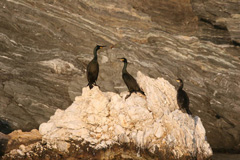
Once the breeding period ends, Shags will either stay alone, or group together, in groups of anything from a few individuals to hundreds of them, and might decide to leave the colony in search of better foraging grounds. The species is present in Greece all year round, and according to data from ringed individuals, can move locally up to 200 km away from their colony.
The Mediterranean Shag in numbers
Length: 0,75 m
Wing span: 1 m
Distribution: Islands and rocky coasts of the Mediterranean and the Black Sea
Greek population: 1000 - 2000 pairs
|
Threats
The species main threats are human disturbance, degradation and loss of habitat both on land and at sea, mammal (rats) or bird (e.g. Yellow-legged Gull) predation, mortality by accidental trapping in fishing gear (by-catch), overfishing and oil spills.
How does the LIFE project help the species
The LIFE project aims to improve the knowledge of the species distribution and ecology both on land and at sea, giving special attention to the designation of Marine IBAs in Greece. In order to achieve these goals, HOS implements classical methodologies of census and monitoring, in combination with other modern technologies such as spatial modelling and radio and GPS telemetry, the latter being particularly effective for the study of the species at sea. At the same time, HOS will carry out management actions against the species main threats, such as rat and Yellow-legged Gull predation, and by-catch.
HOS collaborates with the University of Patras in the elaboration of several PhD theses focused on the species breeding ecology and the phylogeographic differentiation of Greek populations.
By the end of the LIFE project in 2012, a significant improvement is expected in the knowledge of species distribution on land and at seas as well as its conservation status in Greece through the implementation of project concrete conservation actions.









